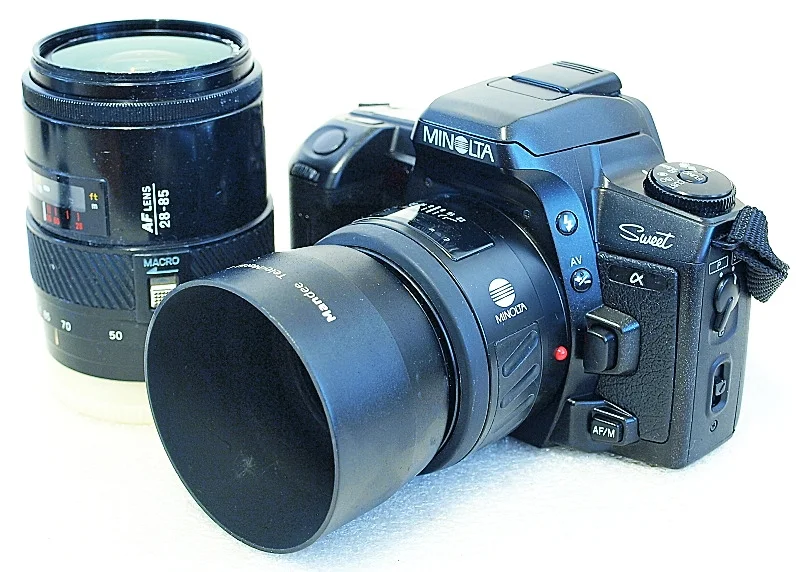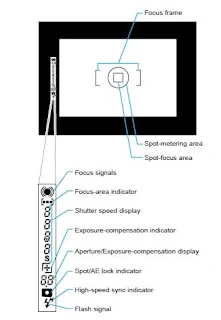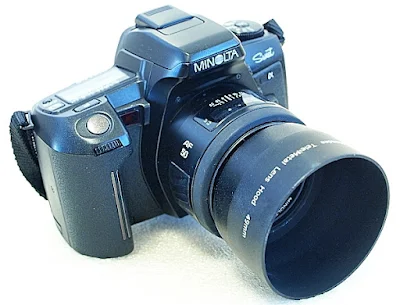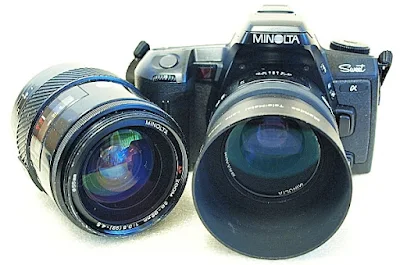The Vintage Enthusiast: A full-featured autofocus 35mm SLR film camera, a budget version of the more advanced Minolta Dynax 700si.
The Minolta Alpha Sweet (Maxxum XTsi in the USA, Dynax 505si Super in Europe), is a Japanese domestic model introduced in 1993 as a budget version of the more advanced Minolta Dynax 700si. The fourth-generation autofocus 35mm SLR film camera from Minolta has a built-in flash, a sophisticated 14-segment honeycomb-metering pattern, a three-point Crosscut AF sensor for accurate autofocusing, eye-start operation, spot metering, and a host of other easy to use and advanced functions.
Operationally, the lightweight A-mount auto-load Alpha Sweet, which by itself is also an SLR film camera with advanced features, has an electronically-controlled vertical-travel metal focal-plane shutter with a shutter speed range from 30 seconds to 1/4000 second, and Bulb, with flash sync at 1/125 second or slower. The camera accepts films with ISO speeds from 25 to 5000 by DX coding and 6 to 6400 by manual setting in 1/3 EV increments.
Metering is TTL open aperture for light averaging or spot-meter reading, with direct TTL metering for flash. Exposure compensation is +/- 3 stops in 1/2 stop increments. The camera can be set for High-Speed or Slow flash sync, 10-second timer delay actuation, and single or triple frame shots with auto-bracketing. Other full automatic functions include focus hold (autofocus lock) AF lock, 3-frames multiple exposures, eye-start with On/Off setting, and automatic film loading and rewind.
A distinguishing feature of the Alpha Sweet is the customized exposure functions which provide for PASM (Program, Aperture-Priority, Shutter-Priority, and Manual) shooting modes, and enhanced settings for Portrait, Landscape, Close-up, Sports, and Night Portrait by a very convenient button selection and icon display along the top edge of the LCD data panel. An extended Night Exposure mode can also be set by setting the flash unit off in Night Portrait mode.
The Top 10 Best and Worst Minolta Cameras Ever (HD Version)
This is an HD version of the video originally posted at Gary Friedman's blog: http://friedmanarchives.blogspot.com/2012/02/top-10-best-and-worst-minolta-cameras.html People wanting to know "Where's the list of the worst Minoltas?" can find it on my blog at my April 2012 blog post: http://friedmanarchives.blogspot.com/2012/04/are-kit-lenses-worthless.html (Scroll half-way down.)
While a fair amount of criticism is pointed towards the kit Minolta 28-80 F3.5-5.6 AF II lens, the Minolta Alpha Sweet 35mm AF SLR film camera is compatible with all Minolta A-mount lenses.
Basic Camera Features
The Alpha Sweet is available in both silver and black, both elegant, with the black having the 'professional' look.The front of the camera body houses the finger grip, with an integrated Grip Sensor, a control dial, and the Shutter button on the slanted top to the left of the lens mount housing, with the Self-timer lamp located between the two. The built-in flash sits on top of the pentaprism. On the right is the Lens-release lock, just above the Focus-mode button. On the vertical of the lens-mount housing are the Exposure-compensation and the Flash-mode buttons.
The top plate is the housing for the operating controls of the camera. On the left, where you would normally find the rewind lever for crank and wind film cameras, is the program function dial with selections for Customization, ISO, Red-Eye Reduction, PASM modes, Multiple Exposure / Exposure bracketing, and Wireless/Remote Flash control.
The top of the pentaprism carries an accessory shoe and on the right is the LCD Data panel which is integrated with Subject Program icons, with the Subject Program button and the Self-timer/Drive mode button beside it. This intuitive control layout provides quick, easy operation for any skill level.
The back of the camera is rather spartan except for the main switch which is right on the edge of the top plate, with the Spot/AE lock button beside it. Towards the middle of the film back is the Spot AF button, the film window to the left, and on the bottom frame, the Manual-rewind button, and the Eye-start button. An eyepiece sensor is integrated within the eyepiece viewfinder housing.
For QD models, the control and display of the data back are on the film, together with the Spot/AF button.
The bottom is all plain except for the battery chamber cover and the tripod socket.
The film box is a sophisticated array of technology starting with the DX sensor film chamber, the vertical blade shutter window, the pick-up sprocket, and the auto-powered take-up spool. Film loading is a simple drop and close, but make sure that the film lead is lined up with the red mark of the take-up spool area. Film rewind can be customized to retain the film lead from being fully wound back into the canister.
Film Loading and Rewind
Film loading and rewinding are both motorized. For loading, the film must be tensioned properly, with any excess pushed back into the film canister, the film end stretched across the film box to the red mark, and the film back closed. The camera will automatically advance the film to Frame 1.The film will be automatically rewound at the end of the roll. To rewind the film mid-way through the roll, press the manual rewind button located on the lower edge of the camera back.
Viewfinder Readout
The display includes a vertical information bar located on the left of the screen, which is displayed when the shutter button is pressed lightly, with a vertical layout for the display of:
- Focus signals
- Focus-area indicator
- Shutter speed display
- Exposure-compensation indicator
- Aperture/Exposure-compensation display
- Spot/AE-lock indicator
- High-speed sync indicator
- Flash signal.
14-Segment Honeycomb-Metering Pattern
The sensor used for metering will be displayed on the focus area indicator of the viewfinder.
Eye-Start Operation
The eye-start, which automatically activates the camera's focus and autoexposure system as you bring the camera to your eye can be abled or disabled to work on power-up to activate the grip-sensor and LCD info panel.The slide switch setting for this function is located on the lower edge of the camera back.
LCD Panel Info
These are prior settings that are set by pressing the Function Button located in the middle of the PASM dial on the left of the top plate while selecting the A, S, or M mode by rotating the control dial located under the shutter release button on the front part of the camera body.
In full manual mode, the aperture setting is handled by the control dial, while setting the aperture requires you to press and hold the exposure compensation button located on the left of the lens mount housing while rotating the control dial to select the aperture setting.
All information relevant to the settings on the camera, and image capture vitals are available as part of the Data Panel display.
Program Controls
Much like the controls you find on a beginner-level DSLR, the Alpha Sweet has all the trappings of a user-friendly system that comes with:- PASM and 5 Subject Program (Portrait, Landscape, Close-up, Sports, Night Portrait) modes,
- a sophisticated 14-segment honeycomb-metering pattern,
- a three-point Crosscut AF sensor for accurate autofocusing,
- an eye-start operation,
- and a rapid subject-program mode selection icon along the top edge of the LCD data panel.
Point-and-Shoot Simplicity
With most of the complications of using a traditional film camera removed, which include loading and unloading the camera, setting film ISO speed, understanding the elements of exposure settings focusing, shutter, and film forward operations, using the Alpha Sweet is down to an almost point-and-shoot simplicity.The motorized film advance mechanism advances the film automatically advances the film to the correct shooting frame, and dutifully rewinds it back into the film canister once all the images have been exposed.
Shooting Modes
These will vary the aperture/speed setting of the camera to adjust:
- to a shallower depth of field for portraits, or the greatest of landscapes,
- the best aperture/speed setting for macros, the fastest possible shutter speed for sports,
- and the largest aperture with a longer shutter speed for night portraits, which will also capture some of the background ambiance of the scene.
Battery
The Minolta Alpha Sweet / Maxxum XTSI / Dynax 505si Super requires a pair of 2CR2 Lithium batteries to operate.Camera Body Weight
The Minolta Alpha Sweet has a body weight of 375/385 grams without a battery.Lens Compatibility
The Alpha Sweet will accept all Minolta's A-mount lenses, which were first released in 1985 with the introduction of Maxxum series SLRs. Generally, all these lenses will also work on Sony Alpha cameras, and the E-mount NEX range, if used with an LA-EA1 or 2 adapters, although there may be restrictions.
Using The Camera
The camera is superlatively easy to use. Just set the selector dial to Programmed Auto, or jiggle your way through the choice of Aperture-Priority, Shutter-Priority, Fully Manual, or any of the Scene Modes and shoot away. Your images are sure to be perfectly focused and exposed.
Well, there you go. If you are thinking about going into, or back to, film photography, and if you looking for a superb lightweight autofocus 35mm film SLR with well-advanced capabilities, then the Alpha Sweet may be the one you should consider looking at.






































No comments:
Post a Comment